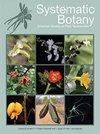Ecological and Evolutionary Origin of Costus flammulus (Costaceae): A New Species from the Montane Cloud Forests of the Volcanic Cordilleras in Northern Costa Rica
IF 0.8
3区 生物学
Q4 EVOLUTIONARY BIOLOGY
引用次数: 0
Abstract
Abstract Costus flammulus is a new herbaceous species endemic to montane cloud forests of the volcanic cordilleras in northern Costa Rica. Costus flammulus has been mistaken for C. wilsonii, but phylogenetic evidence demonstrates that it is closely related to the widespread lowland species C. pulverulentus. Here, we use an integrated framework of species concepts to evaluate whether C. flammulus and C. pulverulentus are distinct species. First, we re-evaluate prior phylogenetic analyses to assess whether C. flammulus bifurcated from or budded off from within C. pulverulentus and whether C. flammulus is monophyletic. We then compare phenotypic traits to determine which diagnostic vegetative and inflorescence traits can be used to identify species in herbarium specimens and examine whether floral traits may confer floral isolation. We compare pollinator assemblages to examine whether pollinator specificity may contribute to reproductive isolation. Finally, we model species distributions and climatic niche overlap to assess ecogeographic isolation. We found that C. flammulus is a monophyletic species phenotypically, ecologically, and geographically distinct from C. pulverulentus and may have speciated as a peripheral isolate at the high elevation range edge of C. pulverulentus. Several lines of evidence, such as C. pulverulentus paraphyly, range size asymmetry, and C. flammulus' nested distribution and vegetative traits, suggest that C. flammulus budded off from a C. pulverulentus-like progenitor species, evolving to tolerate a colder and more seasonal montane environment.Costus flamulus(Costaceae)的生态和进化起源:哥斯达黎加北部火山山脉山地云雾林中的一个新种
文章摘要:火绒Costus flamulus是哥斯达黎加北部火山堇属山地云雾林特有的一种新草本植物。金针菇被误认为是C.wilsonii,但系统发育证据表明,它与广泛分布的低地物种C.pulverulentus密切相关。在这里,我们使用物种概念的综合框架来评估C.flamulus和C.pulverulentus是否是不同的物种。首先,我们重新评估先前的系统发育分析,以评估C.flamulus是否从C.pulverulentus内部分叉或出芽,以及C.flamulous是否为单系。然后,我们比较表型特征,以确定哪些诊断性营养和花序特征可以用于鉴定植物标本中的物种,并检查花特征是否可以赋予花隔离性。我们比较了传粉昆虫组合,以检查传粉昆虫的特异性是否有助于生殖隔离。最后,我们对物种分布和气候生态位重叠进行建模,以评估生态地理孤立性。我们发现,C.flamulus是一个单系物种,在表型、生态和地理上与C.pulverulentus不同,可能在C.pulverluentus的高海拔边缘作为一个外围隔离物物种。一些证据,如C.pulverulentus的寄生性、范围大小不对称、C.flamulus的巢状分布和营养特征,表明C.flamulius是从一个类似C.pulverluentus的祖先物种中分化出来的,进化为能够忍受更冷、更具季节性的山地环境。
本文章由计算机程序翻译,如有差异,请以英文原文为准。
求助全文
约1分钟内获得全文
求助全文
来源期刊

Systematic Botany
生物-进化生物学
CiteScore
1.80
自引率
10.00%
发文量
72
审稿时长
6-12 weeks
期刊介绍:
Systematic Botany Monographs is a series of peer-reviewed taxonomic monographs and revisions published the American Society of Plant Taxonomists. ISSN 0737-8211, ISBN prefix 978-0-912861. No; volumes of Systematic Botany Monographs must be ordered separately. ASPT membership inludes only a subscription to the quarterly journal Systematic Botany. SBM is supported by sales, author"s subsidies, and donations.
 求助内容:
求助内容: 应助结果提醒方式:
应助结果提醒方式:


